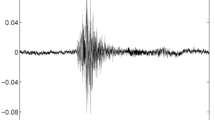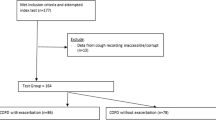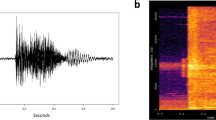Abstract
Cough is the most common symptom of several respiratory diseases. It is a defense mechanism of the body to clear the respiratory tract from foreign materials inhaled accidentally or produced internally by infections. The identification of wet and dry cough is an important clinical finding, aiding in the differential diagnosis especially in children. Wet coughs are more likely to be associated with lower respiratory track bacterial infections. At present during a typical consultation session, the wet/dry decision is based on the subjective judgment of a physician. It is not available for the non-trained person, long term monitoring or in the assessment of treatment efficacy. In this paper we address these issues and develop an automated technology to classify cough into ‘wet’ and ‘dry’ categories. We propose novel features and a Logistic regression model (LRM) for the classification of coughs into wet/dry classes. The performance of the method was evaluated on a clinical database of pediatric coughs (C = 536) recorded using a bed-side non-contact microphone from N = 78 patients. Results of the automatic classification were compared against two expert human scorers. The sensitivity and specificity of the LRM in picking wet coughs were between 87 and 88% with 95% confidence interval on training/validation dataset (310 cough events from 60 patients) and 84 and 76% respectively on prospective dataset (117 cough events from 18 patients). The kappa agreement with two expert human scorers on prospective dataset was 0.51. These results indicate the potential of the method as a useful clinical tool for cough monitoring, especially at home settings.




Similar content being viewed by others
References
Abeyratne, U. R. Blind reconstruction of non-minimum-phase systems from 1-D oblique slices of bispectrum. In: IEE Proceedings of Vision, Image and Signal Processing. IET, 1999.
Chang, A. B. Pediatric cough: children are not miniature adults. Lung 188:33–40, 2010.
Chang, A. B., J. T. Gaffney, M. M. Eastburn, J. Faoagali, N. C. Cox, and I. B. Masters. Cough quality in children: a comparison of subjective versus bronchoscopic findings. Respir. Res. 6, 2005.
Chang, A., G. Redding, and M. Everard. Chronic wet cough: protracted bronchitis, chronic suppurative lung disease and bronchiectasis. Pediatr. Pulmonol. 43:519–531, 2008.
Chatrzarrin, H., A. Arcelus, R. Goubran, and F. Knoefel. Feature extraction for the differentiation of dry and wet cough sounds. In: IEEE International Workshop on Medical Measurements and Applications Proceedings (MeMeA), IEEE, 2011, pp. 162–166.
Chung, K. F., and I. D. Pavord. Prevalence, pathogenesis, and causes of chronic cough. Lancet 371:1364–1374, 2008.
Ghaemmaghami, H., U. Abeyratne, and C. Hukins. Normal probability testing of snore signals for diagnosis of obstructive sleep apnea. In: Engineering in Medicine and Biology Society, 2009. EMBC 2009. Annual International Conference of the IEEE, IEEE, 2009.
Hartigan, J. A., and M. A. Wong. Algorithm AS 136: a k-means clustering algorithm. Appl. Stat. 100–108, 1979.
Ishikawa, S., R. Kasparian, J. Blanco, D. Sotherland, R. Clubb, L. Kenny, J. Workowicz, and K. MacDonell. Observer variability in interpretation of voluntary cough of ‘bronchitics’ and ‘asthmatics’. In: ILSA Proceedings Paris, vol. 10, 1987.
Korpá, J., J. Sadloová, and M. Vrabec. Analysis of the cough sound: an overview. Pulm. Pharmacol. 9:261–268, 1996.
Lee, T., U. Abeyratne, K. Puvanendran, and K. Goh. Formant-structure and phase-coupling analysis of human snoring sounds for detection of obstructive sleep apnea. Comput. Methods Biomech. Biomed. Eng. 3, 2000.
Logan, B. Mel frequency cepstral coefficients for music modeling. In: International Symposium on Music Information Retrieval, 2000.
Mendel, J. M. Tutorial on higher-order statistics (spectra) in signal processing and system theory: theoretical results and some applications. Proc. IEEE 79:278–305, 1991.
Murata, A., Y. Taniguchi, Y. Hashimoto, K. Y., Y. Takasaki, and S. Kudoh. Discrimination of productive and non-productive cough by sound analysis. Intern. Med. 37:732–735, 1998.
Ng, A. K., T. S. Koh, E. Baey, T. H. Lee, U. R. Abeyratne, and K. Puvanendran. Could formant frequencies of snore signals be an alternative means for the diagnosis of obstructive sleep apnea? Sleep Med. 9:894–898, 2008.
Oppenheim, A. V., R. W. Schafer, and J. R. Buck. Discrete-Time Signal Processing, Vol. 1999. Englewood Cliffs, NJ: Prentice hall, 1989.
Piirilä, P., and A. Sovijärvi. Differences in acoustic and dynamic characteristics of spontaneous cough in pulmonary diseases. Chest 96:46–53, 1989.
Quatieri, T. F. Discrete-Time Speech Signal Processing: Principles and Practice. Pearson Education India, 2002.
Smith, J. A., H. L. Ashurst, S. Jack, A. A. Woodcock, and J. E. Earis. The description of cough sounds by healthcare professionals. Cough 2:1, 2006.
Sondhi, M. New methods of pitch extraction. IEEE Trans. Audio Electroacoust. 16:262–266, 1968.
Soto Quiros, M. E., M. Soto Martinez, and L. Å. Hanson. Epidemiological studies of the very high prevalence of asthma and related symptoms among school children in Costa Rica from 1989 to 1998. Pediatr. Allergy immunol. 13:342–349, 2002.
Spengler, J. D., J. J. K. Jaakkola, H. Parise, B. A. Katsnelson, L. I. Privalova, and A. A. Kosheleva. Housing characteristics and children’s respiratory health in the Russian Federation. J. Inf. 94, 2004.
The Global Burden of Disease 2004 Update. World Health Organization, 2008.
Thorpe, C., L. Toop, and K. Dawson. Towards a quantitative description of asthmatic cough sounds. Eur. Respir. J. 5:685–692, 1992.
Thorpe, W., M. Kurver, G. King, and C. Salome. Acoustic analysis of cough. In: Intelligent Information Systems Conference, the Seventh Australian and New Zealand 2001, IEEE, 2001.
Zgherea, D., S. Pagala, M. Mendiratta, M. G. Marcus, S. P. Shelov, and M. Kazachkov. Bronchoscopic findings in children with chronic wet cough. Pediatrics 129:e364–e369, 2012.
Zheng, F., G. Zhang, and Z. Song. Comparison of different implementations of MFCC. J. Comput. Sci. Technol. 16:582–589, 2001.
Author information
Authors and Affiliations
Corresponding author
Additional information
Associate Editor Zahra Moussavi oversaw the review of this article.
Appendices
Appendix 1: Computed Features
For each sub-segment x i following features computed.
-
a)
Bispectrum Score (BGS): The 3rd order spectrum of the signal is known as the bispectrum. Unlike the power spectrum (2nd order statistics) based on the autocorrelation, bispectrum preserves Fourier phase information. The bispectrum can be estimated via estimating the 3rd order cumulant and then taking a 2D-Fourier transform. The 3rd order cumulant C(τ 1,τ 2) was estimated using Eq. (3) as defined in Abeyratne.1 By applying a bispectrum window function (minimum bispectrum-bias supremum window described in Mendel13) to the cumulant estimate, windowed cumulant function \( C_{\text{w}}^{i} (\tau_{ 1} ,\tau_{ 2} ) \) was obtained.
In Eq. (3) Q is the length of the 3rd order correlation lags considered. We used Q as 5% of the length of cough sub-segment. The bispectrum B i(ω 1,ω 2) of the segment x i was estimated using Eq. (4). We used FFT length of 512 points.
In the frequency domain, a quantity P i(ω;ϕ,ρ) can be defined for the data segment x i such that
describing a one-dimensional slice inclined to the ω 1-axis at an angle tan−1 ϕ and shifted from the origin along the ω 2-axis by the amount ρ (−π < ρ < π).2 For this work we set ϕ = 1 and ρ = 0 so that the slice of the bispectrum considered is inclined to the ω 1-axis by 45° and passes through the origin. Then Bispectrum Score (BSG) is computed using Eq. (6). In Eq. (6) we used ω 1 = 90 Hz, ω 2 = 5 kHz, ω 3 = 6 kHz and ω 4 = 10.5 kHz.
-
b)
Non-Gaussianity Score (NGS):7 NGS gives the measure of non-gaussianity of a given segment of data. The normal probability plot can be utilized to obtain a visual measure of the gaussianity of a set of data. The NGS of the data segment x i can be calculated using Eq. (7). Note that in Eq. (7), p and q represents the normal probability plot of the reference normal data and the analyzed data, respectively, with j ranging from the values 1 − N.
-
c)
Formants frequencies: In human voice analysis formants frequencies (FF) are referred as the resonance of the human vocal tract. In cough analysis, it is reasonable to expect that the resonances of the overall airway that contribute to the generation of a cough sound will be represented in the formant structure; mucus can change acoustic properties of airways. We included 1st four FF (F1, F2, F3, F4) in our feature set. Past studies in the speech and acoustic analysis have shown that F1–F4 corresponds to various acoustic features of airway.11,15 We computed F1–F4 by peak picking the Linear Predictive Coding (LPC) spectrum of cough sounds. For this work we used 14th order LPC model with the parameters determined via the Levinson-Durbin recursive procedure.16
-
d)
Pitch: In speech analysis, pitch is defined as the fundamental frequency of the vocal cord.18 Several algorithms have been proposed in the literature to estimate the pitch of a voiced acoustic signal. In this paper we used classical method of ‘autocorrelation with center clipping’20 to compute the pitch of an cough sub-segment.
-
e)
Log Energy(LogE): The log energy for every sub-segment was computed using Eq. (8)
In Eq. (8) ε in (%) is and arbitrarily small positive constant added to prevent any inadvertent computation of the logarithm of 0.
-
f)
Zero crossing (Zcr): The number of zero crossings were counted for each x i sub-segments.
-
g)
Kurtosis (Kurt): The kurtosis is a measure of the peakedness associated with a probability distribution of segment x i, computed using Eq. (9). μ and σ is the mean and stand deviation of the segment x i respectively.
-
h)
Mel-frequency cepstral coefficients (MFCC): MFCCs are commonly used in the music and speech audio signal analysis.12,27 They represent the short term power spectrum of an acoustic signal based on a cosine transform of a log power spectrum on a non-linear mel-scale of frequency. We included the 12 MFCC coefficients in our feature set.
Appendix 2
Kappa statistic is widely used in situations where the agreement between two techniques should be compared. Below are the guidelines for interpreting the Kappa values.
Kappa | Interpretation |
|---|---|
<0 | Less than chance agreement |
0.01–0.20 | Slight agreement |
0.21–0.40 | Fair agreement |
0.41–0.60 | Moderate agreement |
0.61–0.80 | Substantial agreement |
0.81–1 | Almost perfect agreement |
Appendix 3
Definition of the statistical measures used to evaluate the performance of the LRM.
True Positive (TP)—Wet cough correctly identified as ‘WET’ by LRM.
False Positive (FP)—Dry cough incorrectly identified as ‘WET’ by LRM.
True Negative (TN)—Dry cough correctly identified as ‘DRY’ by LRM.
False Negative (FN)—Wet cough incorrectly identified as ‘DRY’ by LRM.
Rights and permissions
About this article
Cite this article
Swarnkar, V., Abeyratne, U.R., Chang, A.B. et al. Automatic Identification of Wet and Dry Cough in Pediatric Patients with Respiratory Diseases. Ann Biomed Eng 41, 1016–1028 (2013). https://doi.org/10.1007/s10439-013-0741-6
Received:
Accepted:
Published:
Issue Date:
DOI: https://doi.org/10.1007/s10439-013-0741-6




